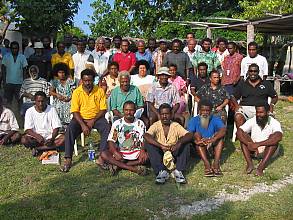
© Vanuatu Cultural Centre
In spite of the freedom given to States in the way they inventory intangible cultural heritage, the Convention does impose several conditions. The most important of these is the one requiring community involvement.
Since communities are the ones who create intangible cultural heritage and keep it alive, they have a privileged place in safeguarding it. The communities that practise intangible cultural heritage are better placed than anyone else to identify and safeguard it, and therefore they should be involved when their intangible cultural heritage is to be identified through inventorying. The Convention’s definition of intangible cultural heritage reminds us that it must be recognized by its communities, groups or individuals; without their recognition, nobody else can decide for them that a given expression or practice is their heritage. So it is natural that inventorying cannot happen without the involvement of the communities, groups or individuals whose heritage is to be identified and defined. Sometimes, of course, communities may not have the power, or the means, to do this on their own. In this case the State, or agencies, institutions and organizations, might work to help them inventory their living heritage.
Documentation consists of recording intangible cultural heritage in tangible forms, in its current state, and collecting documents that relate to it. Documentation often involves the use of various recording means and formats and the collected documents are often preserved in libraries, archives or websites, where they may be consulted by the communities concerned and the larger public. But communities and groups also have traditional forms of documentation such as songbooks or sacred texts, weaving samplers or pattern books, or icons and images that constitute recordings of intangible cultural heritage expressions and knowledge. Innovative community self-documentation efforts and programmes to repatriate or disseminate archival documents in order to encourage continued creativity are some of the proven safeguarding strategies increasingly being used.
Also, Article 13 (d) (ii) stresses that States Parties should always keep in mind customary practices related to providing access to intangible heritage. In some instances, this may mean that certain forms of intangible cultural heritage should not be inventoried or that some intangible cultural heritage already included in inventories should be made public only under certain restrictions. Communities may decide, for instance, to indicate who the custodians of certain knowledge are, rather than recording detailed documentation on sensitive topics in the inventories. Providing information about an element of intangible cultural heritage in an inventory makes access to that element easier. According to the spirit of the Convention, the will of those communities who refuse to include an element of their intangible cultural heritage in an inventory must be respected.
Although some States already and intensively involve communities of intangible cultural heritage bearers, many inventory projects do not yet take into account the provisions of the Convention concerning communities’ involvement. They were often developed by organizations and individuals from outside the communities and often were not created with the aim of ensuring the viability of intangible cultural heritage, as required in the Convention.
States Parties are responsible for making appropriate institutional arrangements for involving communities in the inventory-making process. Such arrangements might include the establishment or designation of intersectoral administrative bodies for assessing relevant existing legislation, institutions and traditional safeguarding systems, as well as for identifying best practices and areas for improvement. Such bodies would be in charge of drawing up inventories of intangible cultural heritage, developing safeguarding policies, developing initiatives to raise awareness about the importance of intangible cultural heritage and encourage public participation in inventorying and safeguarding it. The administrative body should also, where necessary, develop appropriate safeguarding measures for inventoried intangible cultural heritage. States Parties may also wish to establish advisory or consultative bodies that would comprise practitioners and other tradition bearers, researchers, NGOs, civil society, local representatives and relevant others, as well as local support teams including community representatives, cultural practitioners and others with specific skills and knowledge in training and capacity building. Methods for inventorying intangible cultural heritage might be carried out in steps and the identification of all relevant stakeholders and their involvement in the process. Potential consequences of inventorying, procedures to ensure an ethical relationship between stakeholders and customary practices, governing access to the intangible cultural heritage also need to be identified.
Inventorying should be a top-down and bottom-up process involving local communities as well as governments and NGOs. In order for States Parties to satisfy the requirement of communities’ involvement, procedures should be established for:
- Proper identification of communities or groups and their representatives;
- Ensuring that only intangible cultural heritage recognized by the communities or groups is inventoried;
- Ensuring that the free, prior and informed consent of the communities or groups is obtained for inventorying;
- Ensuring the consent of communities when involving non-community members;
- Respecting customary practices regarding access to intangible cultural heritage;
- Actively involving local or regional governments;
- Adopting and following a code of ethics that should take into account the lessons learnt from good practices worldwide.